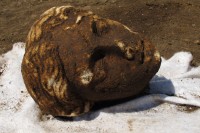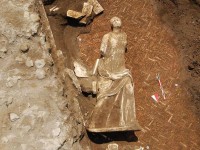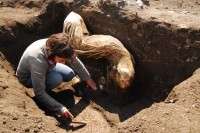 Archaeologists with the regional superintendence of Lazio have unearthed seven statues from the 1st century B.C. on the site of the villa of Marcus Valerius Messalla Corvinus, consul of Rome and patron of the poet of Ovid. The statues are larger than life at around 2 meters (6.5 feet) high and they represent characters from the myth of Niobe, a story Ovid told in Book VI of Metamorphoses.
Archaeologists with the regional superintendence of Lazio have unearthed seven statues from the 1st century B.C. on the site of the villa of Marcus Valerius Messalla Corvinus, consul of Rome and patron of the poet of Ovid. The statues are larger than life at around 2 meters (6.5 feet) high and they represent characters from the myth of Niobe, a story Ovid told in Book VI of Metamorphoses.
Niobe’s story is a classic cautionary tale about hubris. She was the daughter of Tantalus, wife of Amphion, ruler of Thebes, and mother of 14 children known as the Niobids. She unwisely bragged about her fertility at a festival in Thebes celebrating Latona, mother of Apollo and Artemis, questioning why the assembled were worshiping a woman they had never seen who had only two measly offspring when she had seven sons and seven daughters. To punish her pride, Artemis killed her daughters and Apollo killed all her sons. Niobe returned to her birthplace on Mount Sipylus (now in Turkey), turned to stone and wept rivers. There’s a rock formation on Mount Sipylus known as the Weeping Rock which has been identified as the crying Niobe since at least the 3rd century.
This was a popular literary theme in antiquity, mentioned in Greek texts from Homer to Sophocles. Niobid groups were also popular sculptural figures. Although several Roman ones have survived, this is the first relatively intact group that has been discovered in situ during a proper archaeological excavation.
 The discovery was actually made last summer but is only being announced now. In June and July 2012, archaeologists from the superintendence were surveying the site in the town of Ciampino on the outskirts of Rome in anticipation of new construction. They unearthed a thermal bath complex whose pipes were stamped “Valerii Messallae,” identifying the villa as Messalla’s. It also matches the location of the consul’s country estate mentioned in ancient sources.
The discovery was actually made last summer but is only being announced now. In June and July 2012, archaeologists from the superintendence were surveying the site in the town of Ciampino on the outskirts of Rome in anticipation of new construction. They unearthed a thermal bath complex whose pipes were stamped “Valerii Messallae,” identifying the villa as Messalla’s. It also matches the location of the consul’s country estate mentioned in ancient sources.
Next to the baths was a swimming pool that could be as long as 20 meters (around 66 feet). The statues were found inside the swimming pool, probably toppled by an earthquake in the 2nd century A.D. Experts believe they once decorated the four sides of the pool and possibly a centerpiece in the middle of the pool. They have survived in impressively complete condition considering they were knocked into a pool with a herringbone brick floor by an earthquake. There are detached heads and some evidence of earlier repairs, but seven statues are basically intact. A number of fragments of other pieces were also discovered, and archaeologists believe they can be reassembled.
The richness of the find will add to the known iconography of the Niobe story. According to Alessandro Betori, director of the excavation, there are two male youths in the group who are aghast watching the massacre of their brothers. These figures haven’t been seen before in any previously discovered Niobid groups.
 There’s also all kinds of excitement about Messalla’s link to Ovid. The poet would have spent time at that villa. Perhaps the statues inspired his version of the tale, or perhaps his patron commissioned the statues after Ovid’s story. That’s purely a speculative romp, however. There’s no reason to assume a connection between Ovid and these statues. Niobe’s long artistic history was reason enough from Messalla to commission the group and for Ovid to write his version of it entirely independent of each other.
There’s also all kinds of excitement about Messalla’s link to Ovid. The poet would have spent time at that villa. Perhaps the statues inspired his version of the tale, or perhaps his patron commissioned the statues after Ovid’s story. That’s purely a speculative romp, however. There’s no reason to assume a connection between Ovid and these statues. Niobe’s long artistic history was reason enough from Messalla to commission the group and for Ovid to write his version of it entirely independent of each other.
Messalla was a staunch republican who because of his republican ideals found himself on the wrong side of Octavian after the assassination of Julius Caesar. He fled Rome and followed the army of Brutus and Cassius. After their defeat in the Battle of Philippi and subsequent suicide in 42 B.C., Messalla at first switched his allegiance to Mark Antony and then to Octavian. He took Antony’s place as co-consul in 31 B.C. when Antony was stripped of the title and war broke out between Octavian one one side and Antony and Cleopatra on the other. Messalla fought for Octavian at the Battle of Actium, Antony and Cleopatra’s final defeat.
There’s a decent slideshow of the statues, mosaics and site here, and a couple of other pictures worth seeing in this slideshow.